Analysis of Decision-Making and Leadership in Project Management
VerifiedAdded on 2023/06/07
|13
|3605
|302
Essay
AI Summary
This essay examines the crucial role of project leadership in effective decision-making, highlighting its impact on project success. It discusses various components of project leadership, including governance models, responsibilities, stakeholder engagement, communication, risk management, and assurance. The essay emphasizes the importance of sound decision-making processes, outlining steps such as identifying problems, generating solutions, and monitoring results. Different decision-making methods like command, consult, vote, and consensus are explored, along with factors affecting these decisions. The analysis underscores that effective leadership and well-informed decision-making are essential for successful project outcomes, and failure in these areas can lead to project failures.
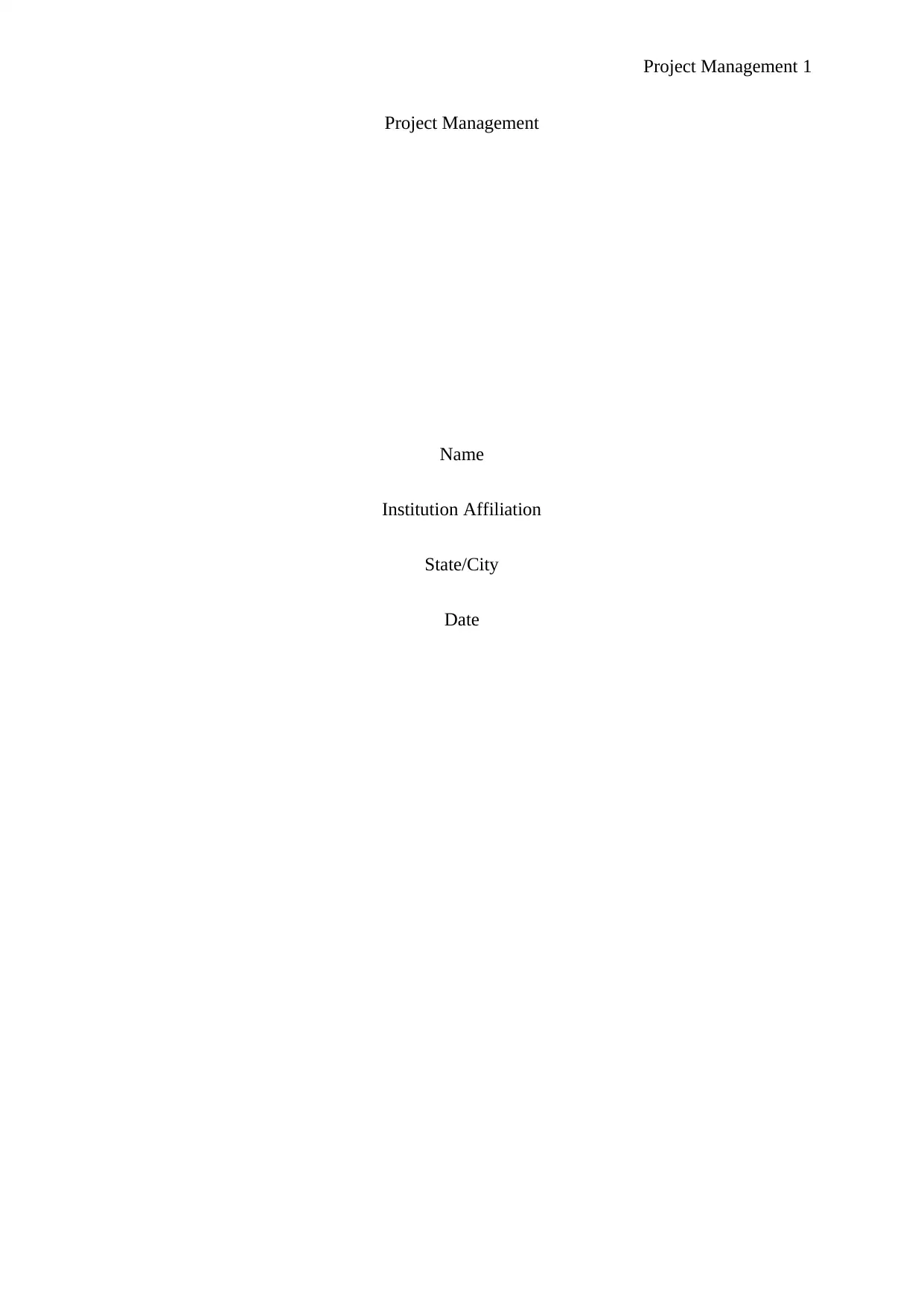
Project Management 1
Project Management
Name
Institution Affiliation
State/City
Date
Project Management
Name
Institution Affiliation
State/City
Date
Paraphrase This Document
Need a fresh take? Get an instant paraphrase of this document with our AI Paraphraser
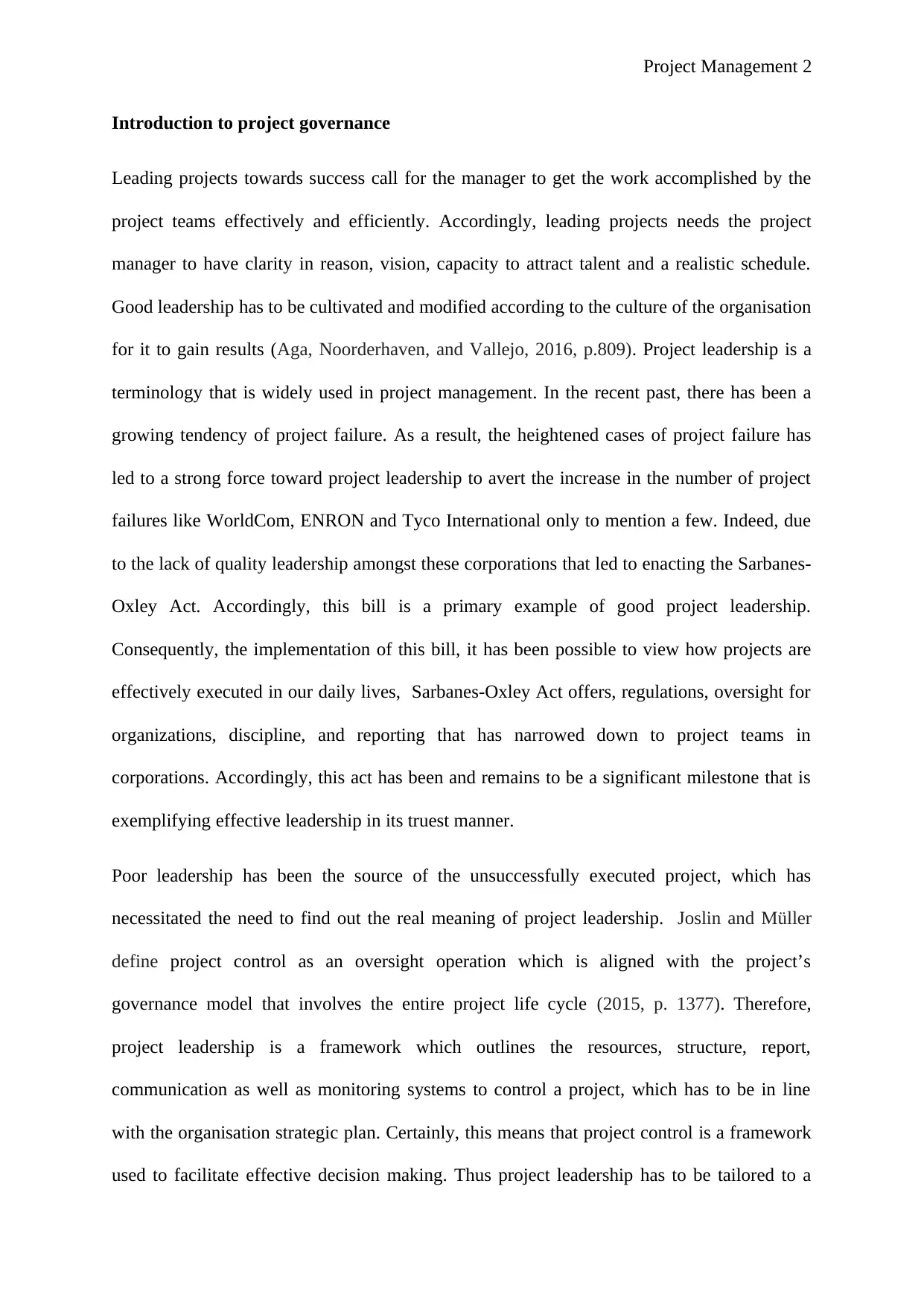
Project Management 2
Introduction to project governance
Leading projects towards success call for the manager to get the work accomplished by the
project teams effectively and efficiently. Accordingly, leading projects needs the project
manager to have clarity in reason, vision, capacity to attract talent and a realistic schedule.
Good leadership has to be cultivated and modified according to the culture of the organisation
for it to gain results (Aga, Noorderhaven, and Vallejo, 2016, p.809). Project leadership is a
terminology that is widely used in project management. In the recent past, there has been a
growing tendency of project failure. As a result, the heightened cases of project failure has
led to a strong force toward project leadership to avert the increase in the number of project
failures like WorldCom, ENRON and Tyco International only to mention a few. Indeed, due
to the lack of quality leadership amongst these corporations that led to enacting the Sarbanes-
Oxley Act. Accordingly, this bill is a primary example of good project leadership.
Consequently, the implementation of this bill, it has been possible to view how projects are
effectively executed in our daily lives, Sarbanes-Oxley Act offers, regulations, oversight for
organizations, discipline, and reporting that has narrowed down to project teams in
corporations. Accordingly, this act has been and remains to be a significant milestone that is
exemplifying effective leadership in its truest manner.
Poor leadership has been the source of the unsuccessfully executed project, which has
necessitated the need to find out the real meaning of project leadership. Joslin and Müller
define project control as an oversight operation which is aligned with the project’s
governance model that involves the entire project life cycle (2015, p. 1377). Therefore,
project leadership is a framework which outlines the resources, structure, report,
communication as well as monitoring systems to control a project, which has to be in line
with the organisation strategic plan. Certainly, this means that project control is a framework
used to facilitate effective decision making. Thus project leadership has to be tailored to a
Introduction to project governance
Leading projects towards success call for the manager to get the work accomplished by the
project teams effectively and efficiently. Accordingly, leading projects needs the project
manager to have clarity in reason, vision, capacity to attract talent and a realistic schedule.
Good leadership has to be cultivated and modified according to the culture of the organisation
for it to gain results (Aga, Noorderhaven, and Vallejo, 2016, p.809). Project leadership is a
terminology that is widely used in project management. In the recent past, there has been a
growing tendency of project failure. As a result, the heightened cases of project failure has
led to a strong force toward project leadership to avert the increase in the number of project
failures like WorldCom, ENRON and Tyco International only to mention a few. Indeed, due
to the lack of quality leadership amongst these corporations that led to enacting the Sarbanes-
Oxley Act. Accordingly, this bill is a primary example of good project leadership.
Consequently, the implementation of this bill, it has been possible to view how projects are
effectively executed in our daily lives, Sarbanes-Oxley Act offers, regulations, oversight for
organizations, discipline, and reporting that has narrowed down to project teams in
corporations. Accordingly, this act has been and remains to be a significant milestone that is
exemplifying effective leadership in its truest manner.
Poor leadership has been the source of the unsuccessfully executed project, which has
necessitated the need to find out the real meaning of project leadership. Joslin and Müller
define project control as an oversight operation which is aligned with the project’s
governance model that involves the entire project life cycle (2015, p. 1377). Therefore,
project leadership is a framework which outlines the resources, structure, report,
communication as well as monitoring systems to control a project, which has to be in line
with the organisation strategic plan. Certainly, this means that project control is a framework
used to facilitate effective decision making. Thus project leadership has to be tailored to a
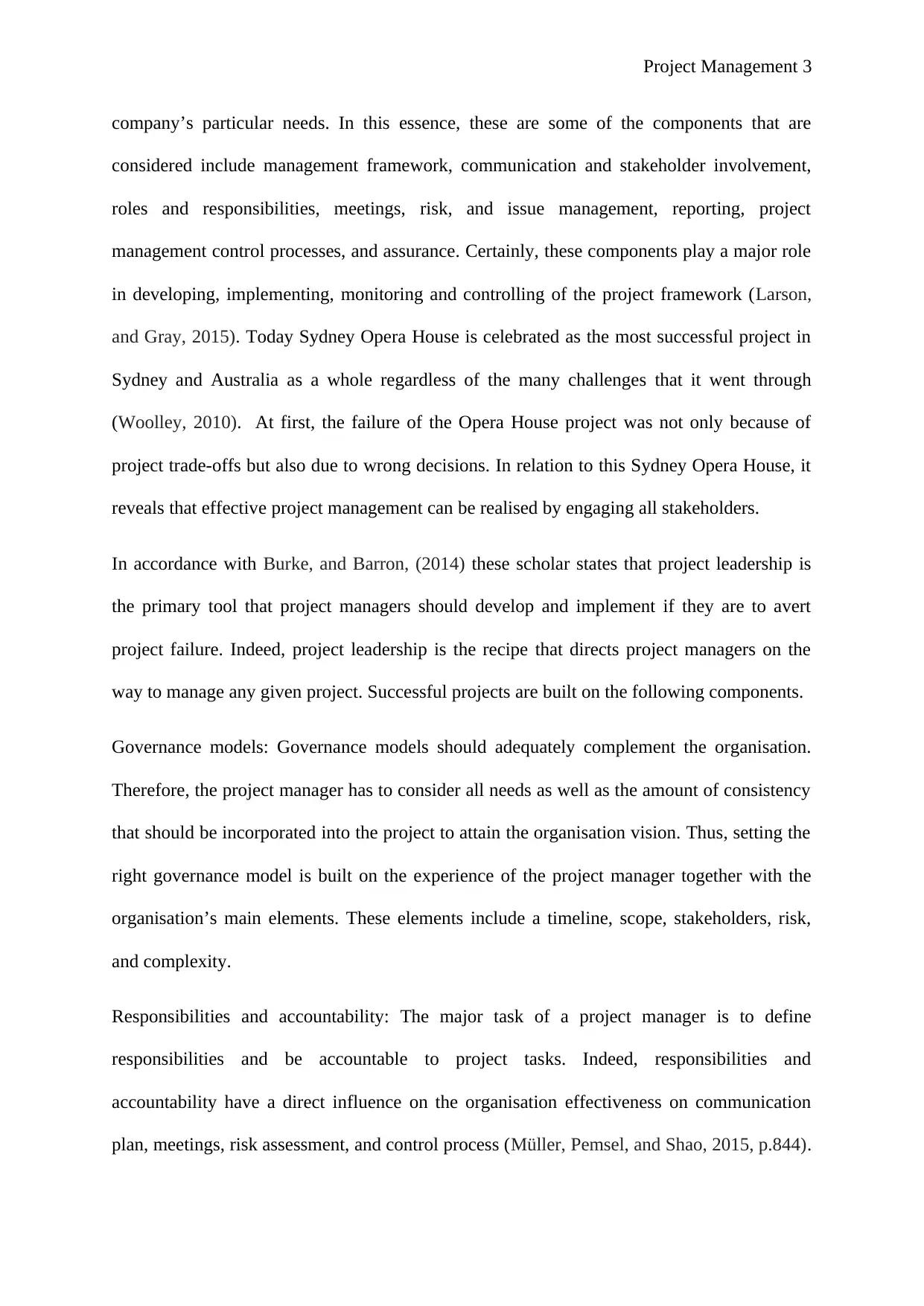
Project Management 3
company’s particular needs. In this essence, these are some of the components that are
considered include management framework, communication and stakeholder involvement,
roles and responsibilities, meetings, risk, and issue management, reporting, project
management control processes, and assurance. Certainly, these components play a major role
in developing, implementing, monitoring and controlling of the project framework (Larson,
and Gray, 2015). Today Sydney Opera House is celebrated as the most successful project in
Sydney and Australia as a whole regardless of the many challenges that it went through
(Woolley, 2010). At first, the failure of the Opera House project was not only because of
project trade-offs but also due to wrong decisions. In relation to this Sydney Opera House, it
reveals that effective project management can be realised by engaging all stakeholders.
In accordance with Burke, and Barron, (2014) these scholar states that project leadership is
the primary tool that project managers should develop and implement if they are to avert
project failure. Indeed, project leadership is the recipe that directs project managers on the
way to manage any given project. Successful projects are built on the following components.
Governance models: Governance models should adequately complement the organisation.
Therefore, the project manager has to consider all needs as well as the amount of consistency
that should be incorporated into the project to attain the organisation vision. Thus, setting the
right governance model is built on the experience of the project manager together with the
organisation’s main elements. These elements include a timeline, scope, stakeholders, risk,
and complexity.
Responsibilities and accountability: The major task of a project manager is to define
responsibilities and be accountable to project tasks. Indeed, responsibilities and
accountability have a direct influence on the organisation effectiveness on communication
plan, meetings, risk assessment, and control process (Müller, Pemsel, and Shao, 2015, p.844).
company’s particular needs. In this essence, these are some of the components that are
considered include management framework, communication and stakeholder involvement,
roles and responsibilities, meetings, risk, and issue management, reporting, project
management control processes, and assurance. Certainly, these components play a major role
in developing, implementing, monitoring and controlling of the project framework (Larson,
and Gray, 2015). Today Sydney Opera House is celebrated as the most successful project in
Sydney and Australia as a whole regardless of the many challenges that it went through
(Woolley, 2010). At first, the failure of the Opera House project was not only because of
project trade-offs but also due to wrong decisions. In relation to this Sydney Opera House, it
reveals that effective project management can be realised by engaging all stakeholders.
In accordance with Burke, and Barron, (2014) these scholar states that project leadership is
the primary tool that project managers should develop and implement if they are to avert
project failure. Indeed, project leadership is the recipe that directs project managers on the
way to manage any given project. Successful projects are built on the following components.
Governance models: Governance models should adequately complement the organisation.
Therefore, the project manager has to consider all needs as well as the amount of consistency
that should be incorporated into the project to attain the organisation vision. Thus, setting the
right governance model is built on the experience of the project manager together with the
organisation’s main elements. These elements include a timeline, scope, stakeholders, risk,
and complexity.
Responsibilities and accountability: The major task of a project manager is to define
responsibilities and be accountable to project tasks. Indeed, responsibilities and
accountability have a direct influence on the organisation effectiveness on communication
plan, meetings, risk assessment, and control process (Müller, Pemsel, and Shao, 2015, p.844).
⊘ This is a preview!⊘
Do you want full access?
Subscribe today to unlock all pages.

Trusted by 1+ million students worldwide
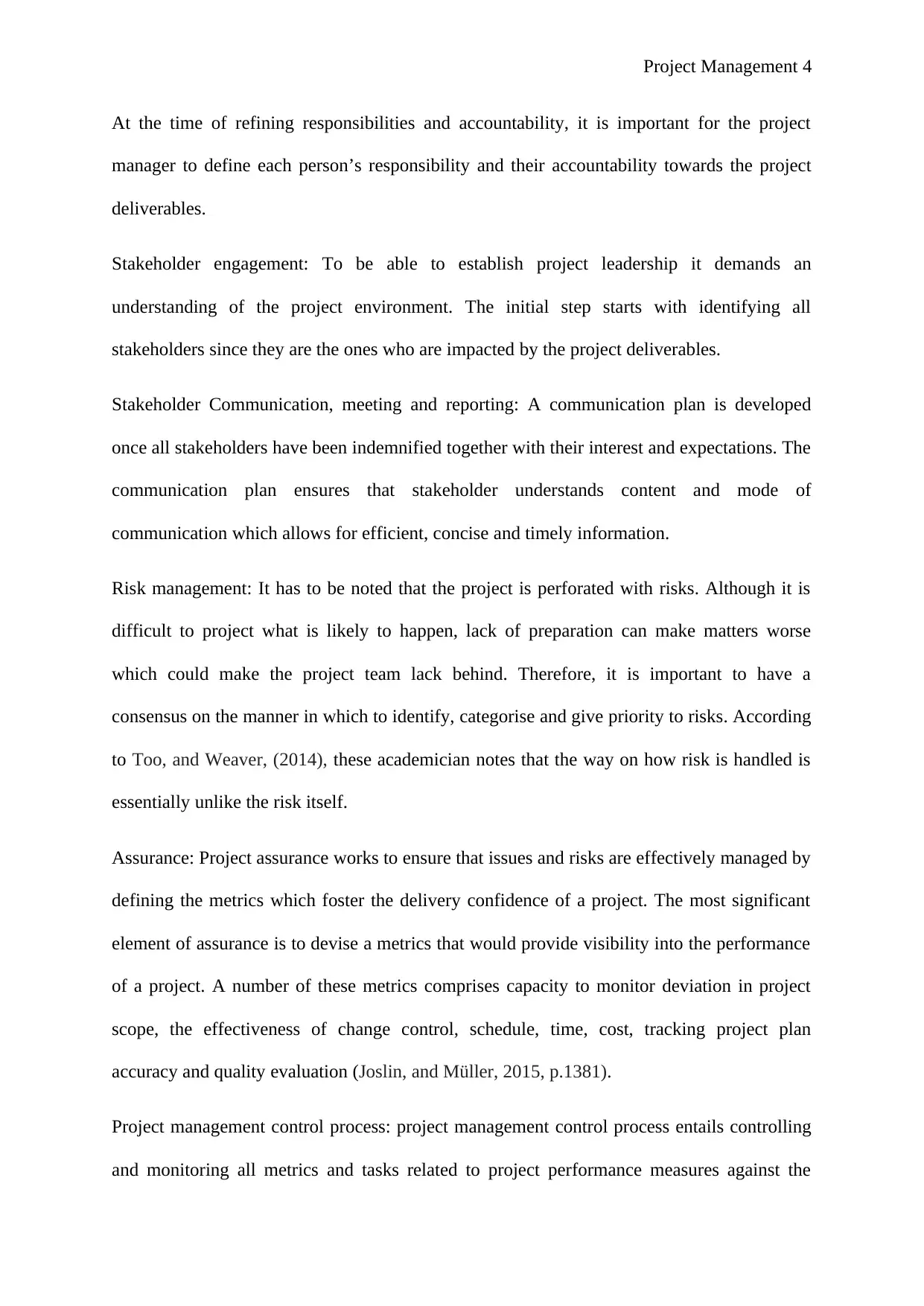
Project Management 4
At the time of refining responsibilities and accountability, it is important for the project
manager to define each person’s responsibility and their accountability towards the project
deliverables.
Stakeholder engagement: To be able to establish project leadership it demands an
understanding of the project environment. The initial step starts with identifying all
stakeholders since they are the ones who are impacted by the project deliverables.
Stakeholder Communication, meeting and reporting: A communication plan is developed
once all stakeholders have been indemnified together with their interest and expectations. The
communication plan ensures that stakeholder understands content and mode of
communication which allows for efficient, concise and timely information.
Risk management: It has to be noted that the project is perforated with risks. Although it is
difficult to project what is likely to happen, lack of preparation can make matters worse
which could make the project team lack behind. Therefore, it is important to have a
consensus on the manner in which to identify, categorise and give priority to risks. According
to Too, and Weaver, (2014), these academician notes that the way on how risk is handled is
essentially unlike the risk itself.
Assurance: Project assurance works to ensure that issues and risks are effectively managed by
defining the metrics which foster the delivery confidence of a project. The most significant
element of assurance is to devise a metrics that would provide visibility into the performance
of a project. A number of these metrics comprises capacity to monitor deviation in project
scope, the effectiveness of change control, schedule, time, cost, tracking project plan
accuracy and quality evaluation (Joslin, and Müller, 2015, p.1381).
Project management control process: project management control process entails controlling
and monitoring all metrics and tasks related to project performance measures against the
At the time of refining responsibilities and accountability, it is important for the project
manager to define each person’s responsibility and their accountability towards the project
deliverables.
Stakeholder engagement: To be able to establish project leadership it demands an
understanding of the project environment. The initial step starts with identifying all
stakeholders since they are the ones who are impacted by the project deliverables.
Stakeholder Communication, meeting and reporting: A communication plan is developed
once all stakeholders have been indemnified together with their interest and expectations. The
communication plan ensures that stakeholder understands content and mode of
communication which allows for efficient, concise and timely information.
Risk management: It has to be noted that the project is perforated with risks. Although it is
difficult to project what is likely to happen, lack of preparation can make matters worse
which could make the project team lack behind. Therefore, it is important to have a
consensus on the manner in which to identify, categorise and give priority to risks. According
to Too, and Weaver, (2014), these academician notes that the way on how risk is handled is
essentially unlike the risk itself.
Assurance: Project assurance works to ensure that issues and risks are effectively managed by
defining the metrics which foster the delivery confidence of a project. The most significant
element of assurance is to devise a metrics that would provide visibility into the performance
of a project. A number of these metrics comprises capacity to monitor deviation in project
scope, the effectiveness of change control, schedule, time, cost, tracking project plan
accuracy and quality evaluation (Joslin, and Müller, 2015, p.1381).
Project management control process: project management control process entails controlling
and monitoring all metrics and tasks related to project performance measures against the
Paraphrase This Document
Need a fresh take? Get an instant paraphrase of this document with our AI Paraphraser
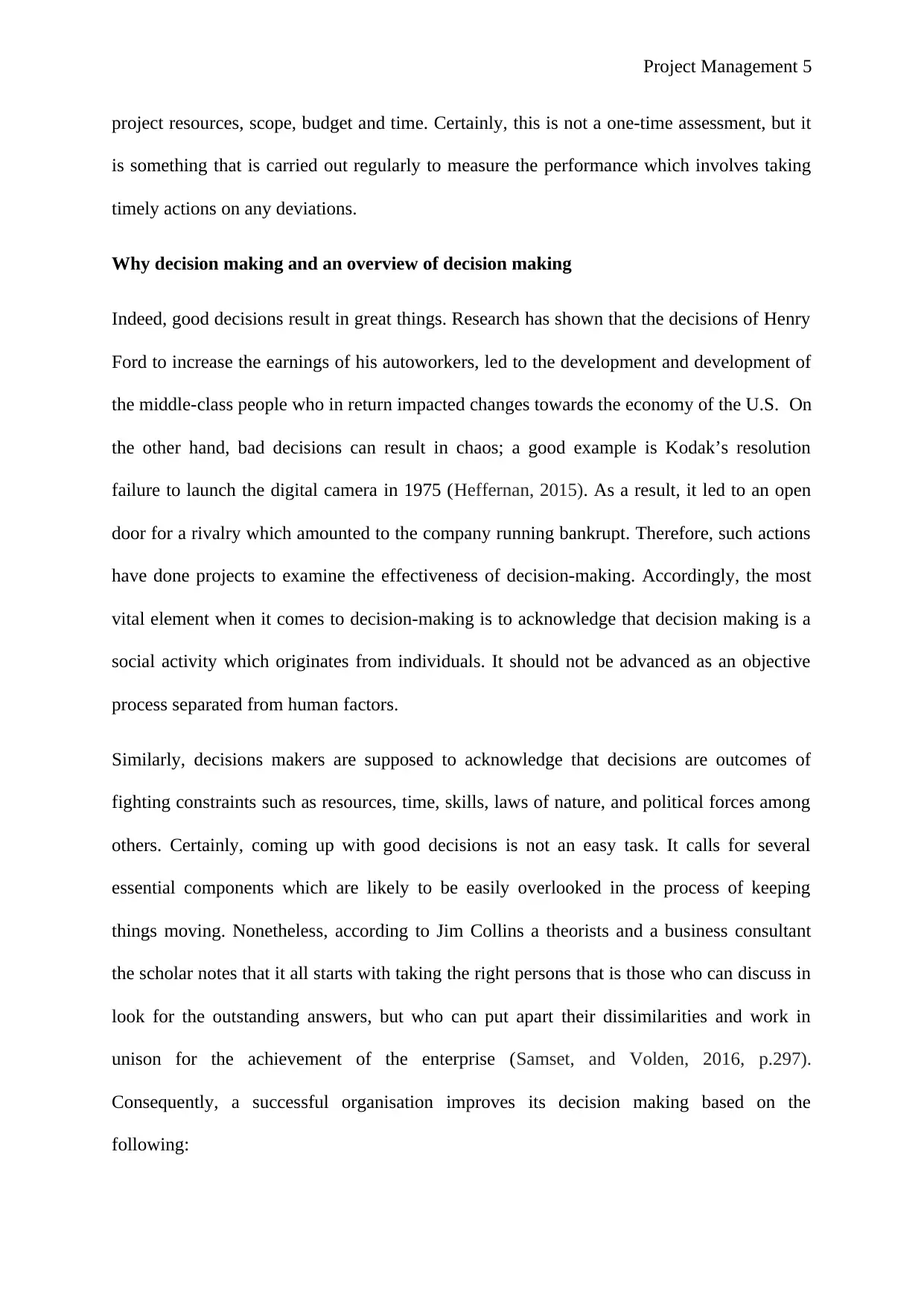
Project Management 5
project resources, scope, budget and time. Certainly, this is not a one-time assessment, but it
is something that is carried out regularly to measure the performance which involves taking
timely actions on any deviations.
Why decision making and an overview of decision making
Indeed, good decisions result in great things. Research has shown that the decisions of Henry
Ford to increase the earnings of his autoworkers, led to the development and development of
the middle-class people who in return impacted changes towards the economy of the U.S. On
the other hand, bad decisions can result in chaos; a good example is Kodak’s resolution
failure to launch the digital camera in 1975 (Heffernan, 2015). As a result, it led to an open
door for a rivalry which amounted to the company running bankrupt. Therefore, such actions
have done projects to examine the effectiveness of decision-making. Accordingly, the most
vital element when it comes to decision-making is to acknowledge that decision making is a
social activity which originates from individuals. It should not be advanced as an objective
process separated from human factors.
Similarly, decisions makers are supposed to acknowledge that decisions are outcomes of
fighting constraints such as resources, time, skills, laws of nature, and political forces among
others. Certainly, coming up with good decisions is not an easy task. It calls for several
essential components which are likely to be easily overlooked in the process of keeping
things moving. Nonetheless, according to Jim Collins a theorists and a business consultant
the scholar notes that it all starts with taking the right persons that is those who can discuss in
look for the outstanding answers, but who can put apart their dissimilarities and work in
unison for the achievement of the enterprise (Samset, and Volden, 2016, p.297).
Consequently, a successful organisation improves its decision making based on the
following:
project resources, scope, budget and time. Certainly, this is not a one-time assessment, but it
is something that is carried out regularly to measure the performance which involves taking
timely actions on any deviations.
Why decision making and an overview of decision making
Indeed, good decisions result in great things. Research has shown that the decisions of Henry
Ford to increase the earnings of his autoworkers, led to the development and development of
the middle-class people who in return impacted changes towards the economy of the U.S. On
the other hand, bad decisions can result in chaos; a good example is Kodak’s resolution
failure to launch the digital camera in 1975 (Heffernan, 2015). As a result, it led to an open
door for a rivalry which amounted to the company running bankrupt. Therefore, such actions
have done projects to examine the effectiveness of decision-making. Accordingly, the most
vital element when it comes to decision-making is to acknowledge that decision making is a
social activity which originates from individuals. It should not be advanced as an objective
process separated from human factors.
Similarly, decisions makers are supposed to acknowledge that decisions are outcomes of
fighting constraints such as resources, time, skills, laws of nature, and political forces among
others. Certainly, coming up with good decisions is not an easy task. It calls for several
essential components which are likely to be easily overlooked in the process of keeping
things moving. Nonetheless, according to Jim Collins a theorists and a business consultant
the scholar notes that it all starts with taking the right persons that is those who can discuss in
look for the outstanding answers, but who can put apart their dissimilarities and work in
unison for the achievement of the enterprise (Samset, and Volden, 2016, p.297).
Consequently, a successful organisation improves its decision making based on the
following:
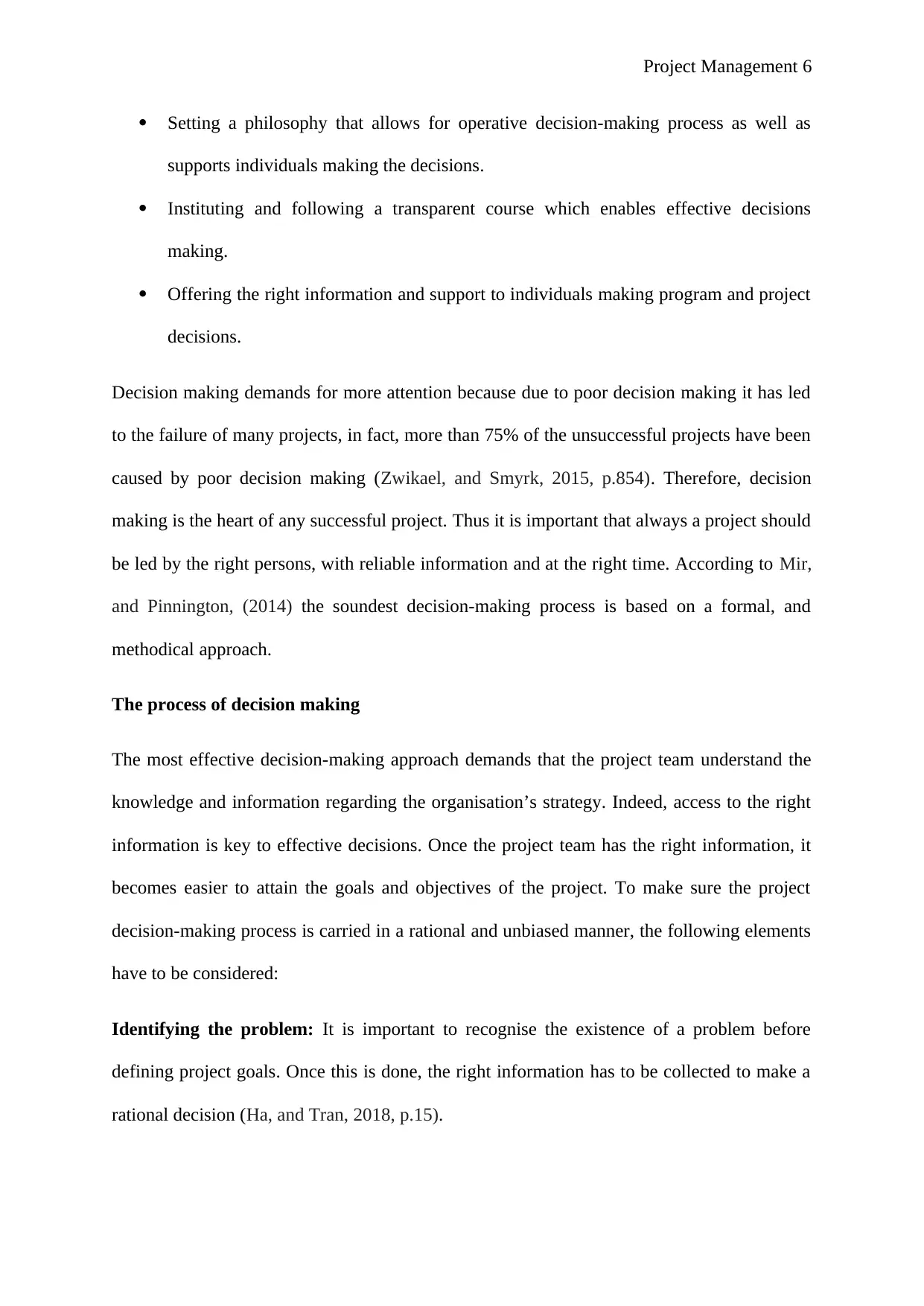
Project Management 6
Setting a philosophy that allows for operative decision-making process as well as
supports individuals making the decisions.
Instituting and following a transparent course which enables effective decisions
making.
Offering the right information and support to individuals making program and project
decisions.
Decision making demands for more attention because due to poor decision making it has led
to the failure of many projects, in fact, more than 75% of the unsuccessful projects have been
caused by poor decision making (Zwikael, and Smyrk, 2015, p.854). Therefore, decision
making is the heart of any successful project. Thus it is important that always a project should
be led by the right persons, with reliable information and at the right time. According to Mir,
and Pinnington, (2014) the soundest decision-making process is based on a formal, and
methodical approach.
The process of decision making
The most effective decision-making approach demands that the project team understand the
knowledge and information regarding the organisation’s strategy. Indeed, access to the right
information is key to effective decisions. Once the project team has the right information, it
becomes easier to attain the goals and objectives of the project. To make sure the project
decision-making process is carried in a rational and unbiased manner, the following elements
have to be considered:
Identifying the problem: It is important to recognise the existence of a problem before
defining project goals. Once this is done, the right information has to be collected to make a
rational decision (Ha, and Tran, 2018, p.15).
Setting a philosophy that allows for operative decision-making process as well as
supports individuals making the decisions.
Instituting and following a transparent course which enables effective decisions
making.
Offering the right information and support to individuals making program and project
decisions.
Decision making demands for more attention because due to poor decision making it has led
to the failure of many projects, in fact, more than 75% of the unsuccessful projects have been
caused by poor decision making (Zwikael, and Smyrk, 2015, p.854). Therefore, decision
making is the heart of any successful project. Thus it is important that always a project should
be led by the right persons, with reliable information and at the right time. According to Mir,
and Pinnington, (2014) the soundest decision-making process is based on a formal, and
methodical approach.
The process of decision making
The most effective decision-making approach demands that the project team understand the
knowledge and information regarding the organisation’s strategy. Indeed, access to the right
information is key to effective decisions. Once the project team has the right information, it
becomes easier to attain the goals and objectives of the project. To make sure the project
decision-making process is carried in a rational and unbiased manner, the following elements
have to be considered:
Identifying the problem: It is important to recognise the existence of a problem before
defining project goals. Once this is done, the right information has to be collected to make a
rational decision (Ha, and Tran, 2018, p.15).
⊘ This is a preview!⊘
Do you want full access?
Subscribe today to unlock all pages.

Trusted by 1+ million students worldwide
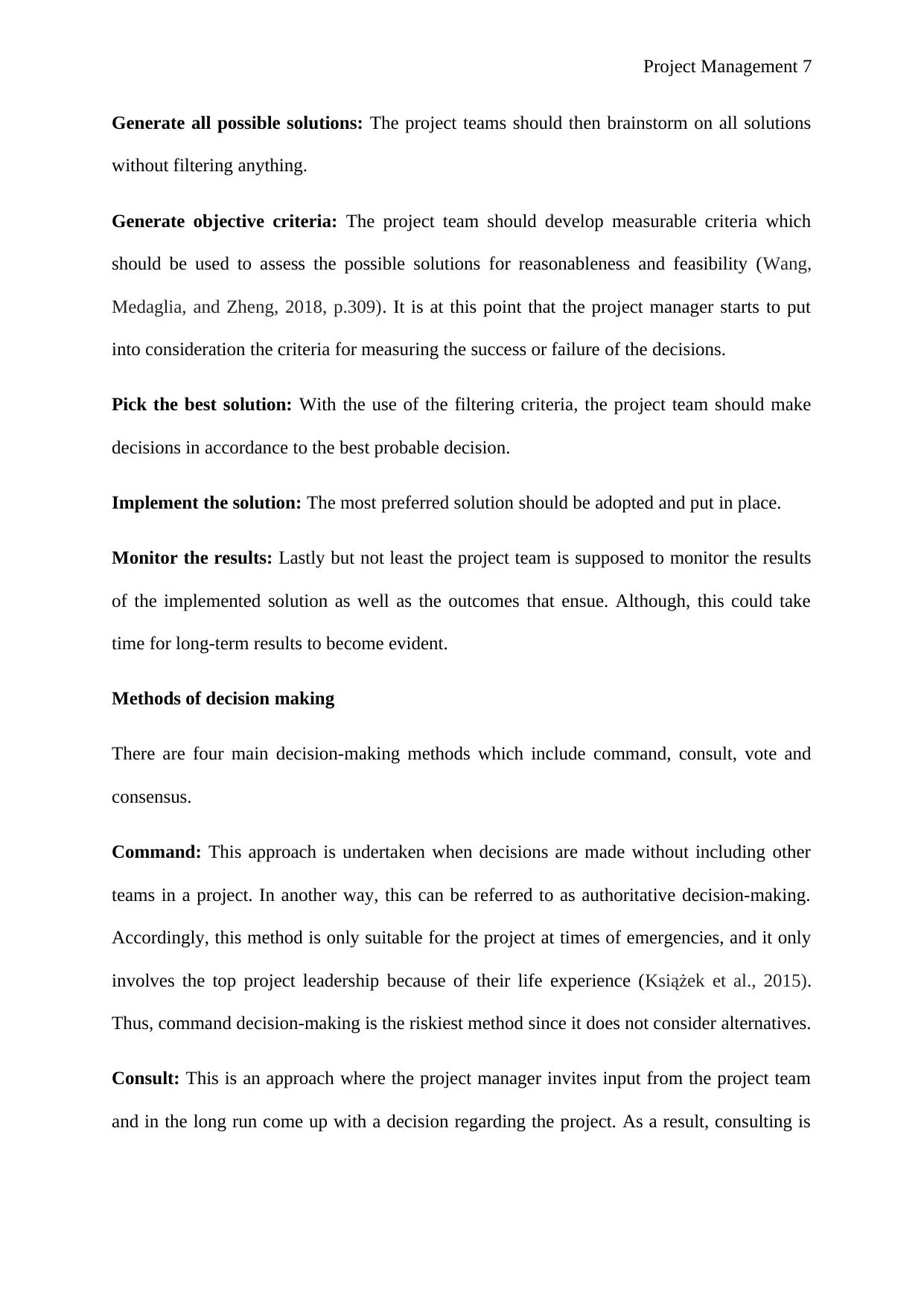
Project Management 7
Generate all possible solutions: The project teams should then brainstorm on all solutions
without filtering anything.
Generate objective criteria: The project team should develop measurable criteria which
should be used to assess the possible solutions for reasonableness and feasibility (Wang,
Medaglia, and Zheng, 2018, p.309). It is at this point that the project manager starts to put
into consideration the criteria for measuring the success or failure of the decisions.
Pick the best solution: With the use of the filtering criteria, the project team should make
decisions in accordance to the best probable decision.
Implement the solution: The most preferred solution should be adopted and put in place.
Monitor the results: Lastly but not least the project team is supposed to monitor the results
of the implemented solution as well as the outcomes that ensue. Although, this could take
time for long-term results to become evident.
Methods of decision making
There are four main decision-making methods which include command, consult, vote and
consensus.
Command: This approach is undertaken when decisions are made without including other
teams in a project. In another way, this can be referred to as authoritative decision-making.
Accordingly, this method is only suitable for the project at times of emergencies, and it only
involves the top project leadership because of their life experience (Książek et al., 2015).
Thus, command decision-making is the riskiest method since it does not consider alternatives.
Consult: This is an approach where the project manager invites input from the project team
and in the long run come up with a decision regarding the project. As a result, consulting is
Generate all possible solutions: The project teams should then brainstorm on all solutions
without filtering anything.
Generate objective criteria: The project team should develop measurable criteria which
should be used to assess the possible solutions for reasonableness and feasibility (Wang,
Medaglia, and Zheng, 2018, p.309). It is at this point that the project manager starts to put
into consideration the criteria for measuring the success or failure of the decisions.
Pick the best solution: With the use of the filtering criteria, the project team should make
decisions in accordance to the best probable decision.
Implement the solution: The most preferred solution should be adopted and put in place.
Monitor the results: Lastly but not least the project team is supposed to monitor the results
of the implemented solution as well as the outcomes that ensue. Although, this could take
time for long-term results to become evident.
Methods of decision making
There are four main decision-making methods which include command, consult, vote and
consensus.
Command: This approach is undertaken when decisions are made without including other
teams in a project. In another way, this can be referred to as authoritative decision-making.
Accordingly, this method is only suitable for the project at times of emergencies, and it only
involves the top project leadership because of their life experience (Książek et al., 2015).
Thus, command decision-making is the riskiest method since it does not consider alternatives.
Consult: This is an approach where the project manager invites input from the project team
and in the long run come up with a decision regarding the project. As a result, consulting is
Paraphrase This Document
Need a fresh take? Get an instant paraphrase of this document with our AI Paraphraser
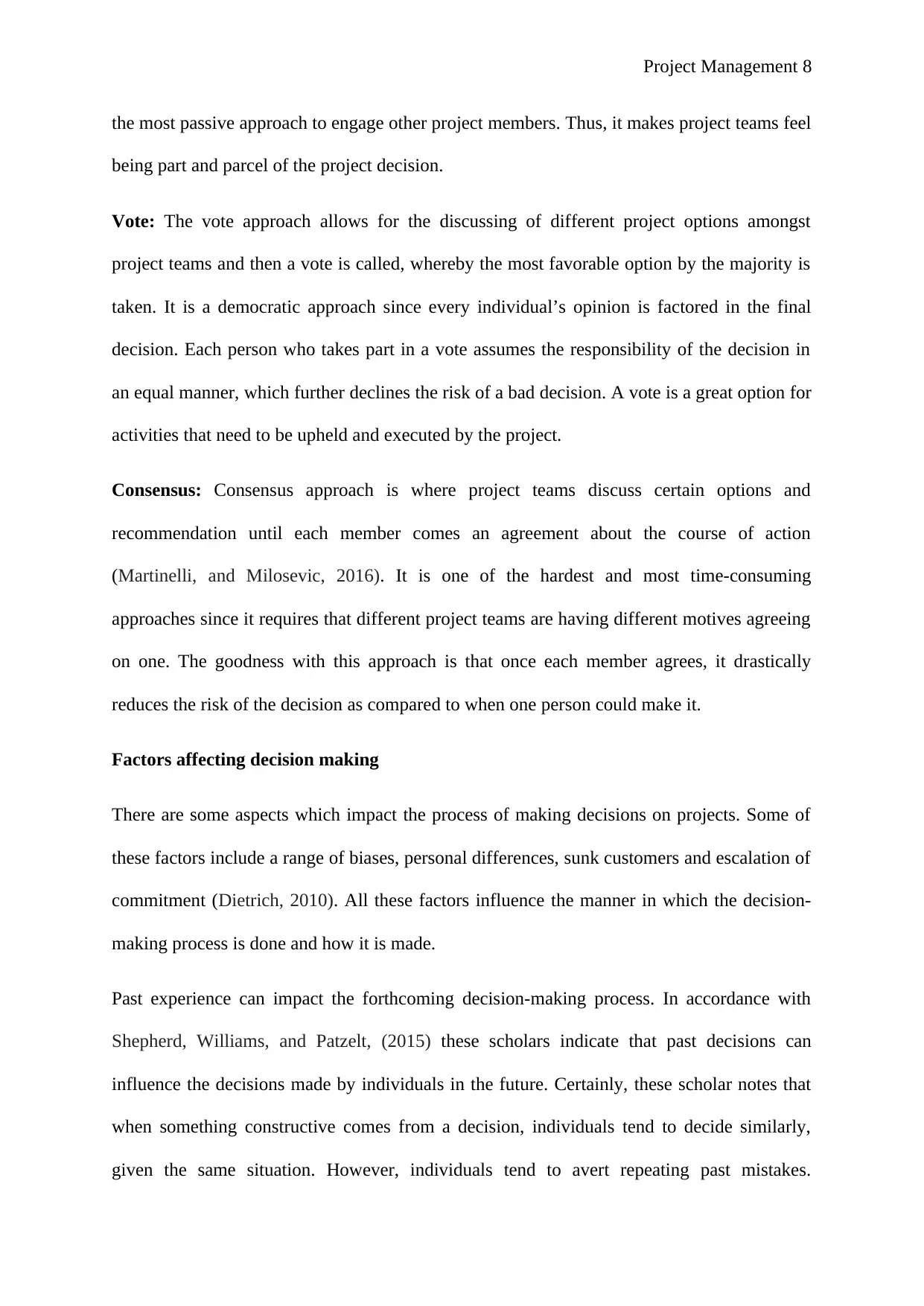
Project Management 8
the most passive approach to engage other project members. Thus, it makes project teams feel
being part and parcel of the project decision.
Vote: The vote approach allows for the discussing of different project options amongst
project teams and then a vote is called, whereby the most favorable option by the majority is
taken. It is a democratic approach since every individual’s opinion is factored in the final
decision. Each person who takes part in a vote assumes the responsibility of the decision in
an equal manner, which further declines the risk of a bad decision. A vote is a great option for
activities that need to be upheld and executed by the project.
Consensus: Consensus approach is where project teams discuss certain options and
recommendation until each member comes an agreement about the course of action
(Martinelli, and Milosevic, 2016). It is one of the hardest and most time-consuming
approaches since it requires that different project teams are having different motives agreeing
on one. The goodness with this approach is that once each member agrees, it drastically
reduces the risk of the decision as compared to when one person could make it.
Factors affecting decision making
There are some aspects which impact the process of making decisions on projects. Some of
these factors include a range of biases, personal differences, sunk customers and escalation of
commitment (Dietrich, 2010). All these factors influence the manner in which the decision-
making process is done and how it is made.
Past experience can impact the forthcoming decision-making process. In accordance with
Shepherd, Williams, and Patzelt, (2015) these scholars indicate that past decisions can
influence the decisions made by individuals in the future. Certainly, these scholar notes that
when something constructive comes from a decision, individuals tend to decide similarly,
given the same situation. However, individuals tend to avert repeating past mistakes.
the most passive approach to engage other project members. Thus, it makes project teams feel
being part and parcel of the project decision.
Vote: The vote approach allows for the discussing of different project options amongst
project teams and then a vote is called, whereby the most favorable option by the majority is
taken. It is a democratic approach since every individual’s opinion is factored in the final
decision. Each person who takes part in a vote assumes the responsibility of the decision in
an equal manner, which further declines the risk of a bad decision. A vote is a great option for
activities that need to be upheld and executed by the project.
Consensus: Consensus approach is where project teams discuss certain options and
recommendation until each member comes an agreement about the course of action
(Martinelli, and Milosevic, 2016). It is one of the hardest and most time-consuming
approaches since it requires that different project teams are having different motives agreeing
on one. The goodness with this approach is that once each member agrees, it drastically
reduces the risk of the decision as compared to when one person could make it.
Factors affecting decision making
There are some aspects which impact the process of making decisions on projects. Some of
these factors include a range of biases, personal differences, sunk customers and escalation of
commitment (Dietrich, 2010). All these factors influence the manner in which the decision-
making process is done and how it is made.
Past experience can impact the forthcoming decision-making process. In accordance with
Shepherd, Williams, and Patzelt, (2015) these scholars indicate that past decisions can
influence the decisions made by individuals in the future. Certainly, these scholar notes that
when something constructive comes from a decision, individuals tend to decide similarly,
given the same situation. However, individuals tend to avert repeating past mistakes.
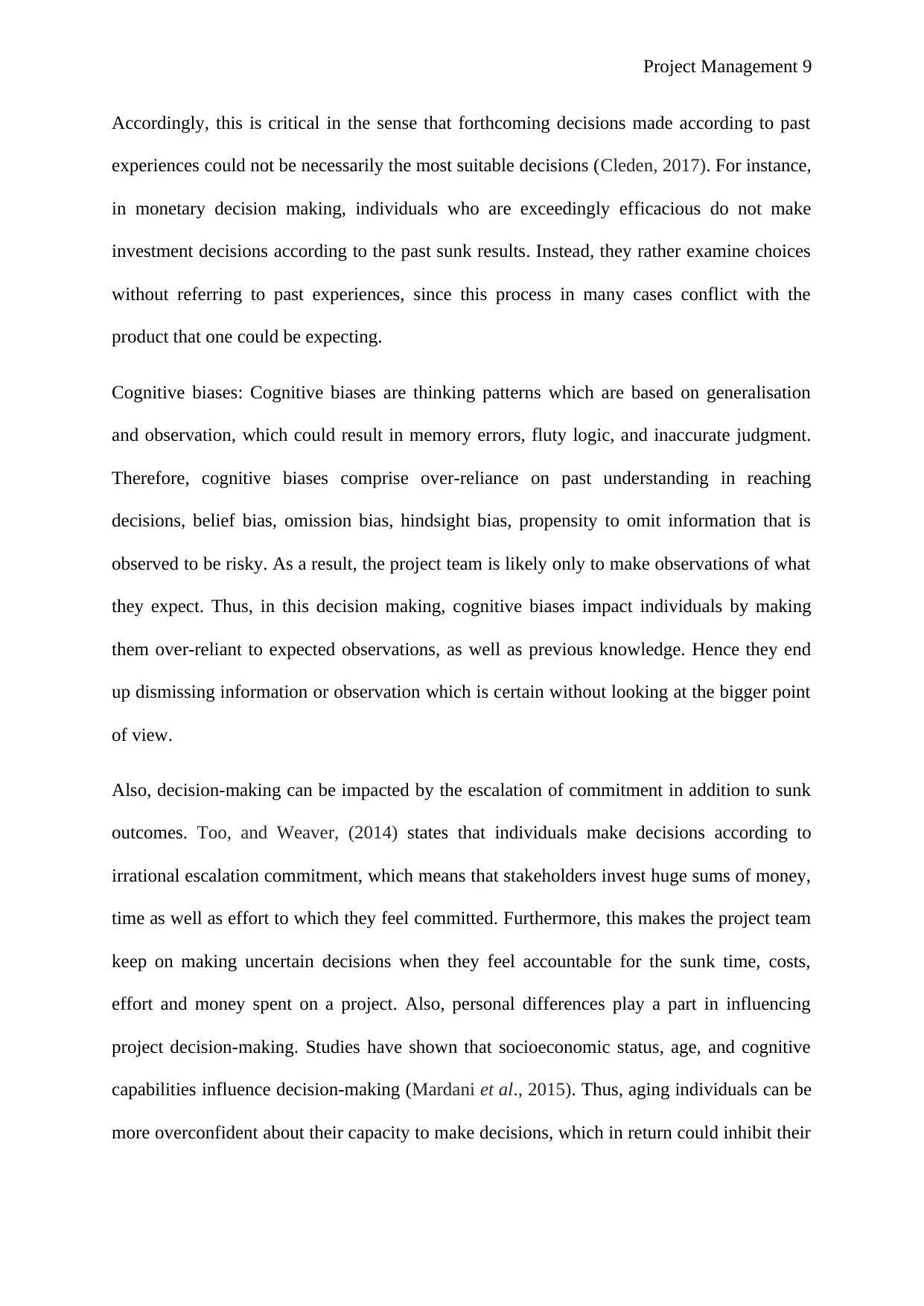
Project Management 9
Accordingly, this is critical in the sense that forthcoming decisions made according to past
experiences could not be necessarily the most suitable decisions (Cleden, 2017). For instance,
in monetary decision making, individuals who are exceedingly efficacious do not make
investment decisions according to the past sunk results. Instead, they rather examine choices
without referring to past experiences, since this process in many cases conflict with the
product that one could be expecting.
Cognitive biases: Cognitive biases are thinking patterns which are based on generalisation
and observation, which could result in memory errors, fluty logic, and inaccurate judgment.
Therefore, cognitive biases comprise over-reliance on past understanding in reaching
decisions, belief bias, omission bias, hindsight bias, propensity to omit information that is
observed to be risky. As a result, the project team is likely only to make observations of what
they expect. Thus, in this decision making, cognitive biases impact individuals by making
them over-reliant to expected observations, as well as previous knowledge. Hence they end
up dismissing information or observation which is certain without looking at the bigger point
of view.
Also, decision-making can be impacted by the escalation of commitment in addition to sunk
outcomes. Too, and Weaver, (2014) states that individuals make decisions according to
irrational escalation commitment, which means that stakeholders invest huge sums of money,
time as well as effort to which they feel committed. Furthermore, this makes the project team
keep on making uncertain decisions when they feel accountable for the sunk time, costs,
effort and money spent on a project. Also, personal differences play a part in influencing
project decision-making. Studies have shown that socioeconomic status, age, and cognitive
capabilities influence decision-making (Mardani et al., 2015). Thus, aging individuals can be
more overconfident about their capacity to make decisions, which in return could inhibit their
Accordingly, this is critical in the sense that forthcoming decisions made according to past
experiences could not be necessarily the most suitable decisions (Cleden, 2017). For instance,
in monetary decision making, individuals who are exceedingly efficacious do not make
investment decisions according to the past sunk results. Instead, they rather examine choices
without referring to past experiences, since this process in many cases conflict with the
product that one could be expecting.
Cognitive biases: Cognitive biases are thinking patterns which are based on generalisation
and observation, which could result in memory errors, fluty logic, and inaccurate judgment.
Therefore, cognitive biases comprise over-reliance on past understanding in reaching
decisions, belief bias, omission bias, hindsight bias, propensity to omit information that is
observed to be risky. As a result, the project team is likely only to make observations of what
they expect. Thus, in this decision making, cognitive biases impact individuals by making
them over-reliant to expected observations, as well as previous knowledge. Hence they end
up dismissing information or observation which is certain without looking at the bigger point
of view.
Also, decision-making can be impacted by the escalation of commitment in addition to sunk
outcomes. Too, and Weaver, (2014) states that individuals make decisions according to
irrational escalation commitment, which means that stakeholders invest huge sums of money,
time as well as effort to which they feel committed. Furthermore, this makes the project team
keep on making uncertain decisions when they feel accountable for the sunk time, costs,
effort and money spent on a project. Also, personal differences play a part in influencing
project decision-making. Studies have shown that socioeconomic status, age, and cognitive
capabilities influence decision-making (Mardani et al., 2015). Thus, aging individuals can be
more overconfident about their capacity to make decisions, which in return could inhibit their
⊘ This is a preview!⊘
Do you want full access?
Subscribe today to unlock all pages.

Trusted by 1+ million students worldwide
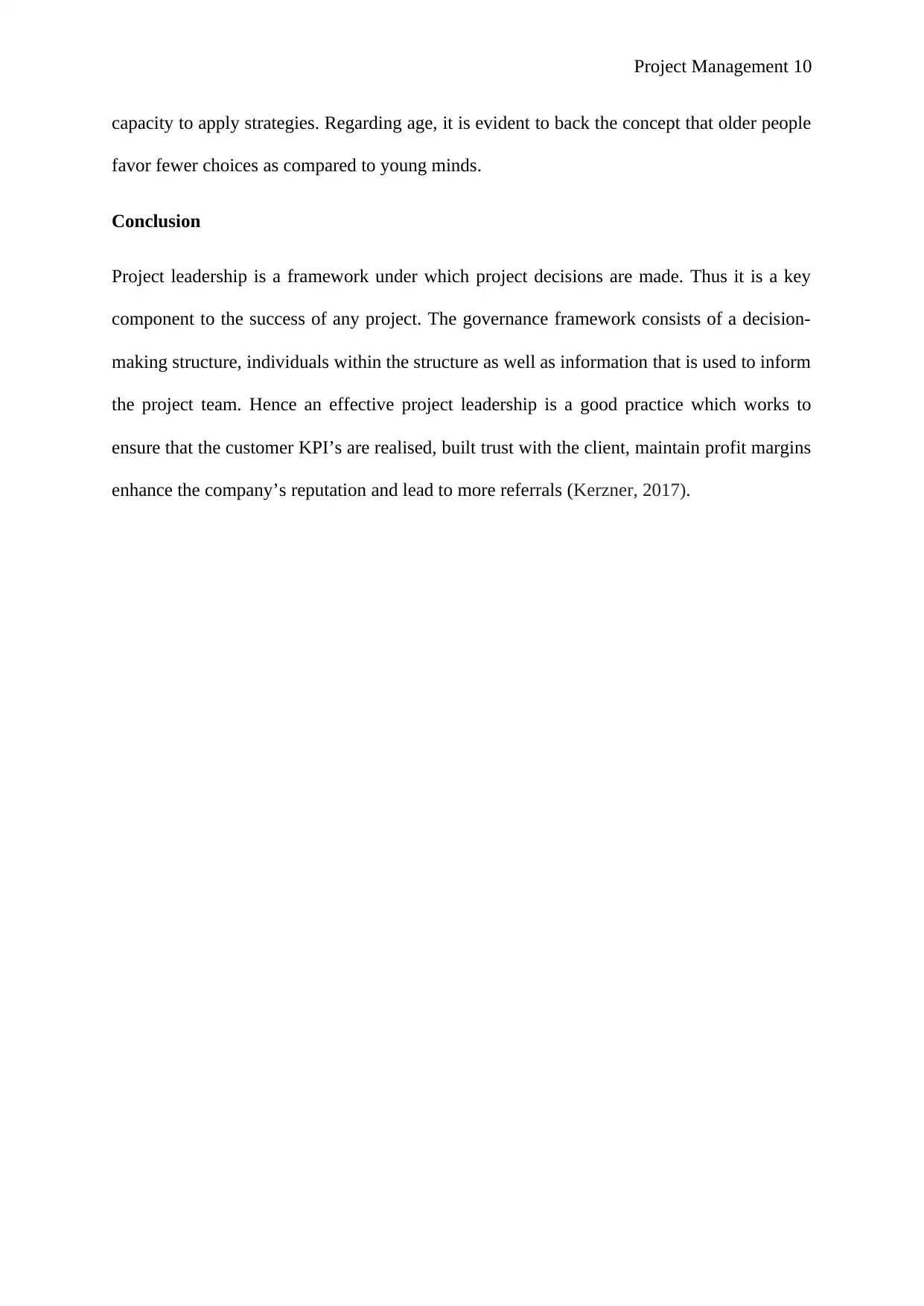
Project Management 10
capacity to apply strategies. Regarding age, it is evident to back the concept that older people
favor fewer choices as compared to young minds.
Conclusion
Project leadership is a framework under which project decisions are made. Thus it is a key
component to the success of any project. The governance framework consists of a decision-
making structure, individuals within the structure as well as information that is used to inform
the project team. Hence an effective project leadership is a good practice which works to
ensure that the customer KPI’s are realised, built trust with the client, maintain profit margins
enhance the company’s reputation and lead to more referrals (Kerzner, 2017).
capacity to apply strategies. Regarding age, it is evident to back the concept that older people
favor fewer choices as compared to young minds.
Conclusion
Project leadership is a framework under which project decisions are made. Thus it is a key
component to the success of any project. The governance framework consists of a decision-
making structure, individuals within the structure as well as information that is used to inform
the project team. Hence an effective project leadership is a good practice which works to
ensure that the customer KPI’s are realised, built trust with the client, maintain profit margins
enhance the company’s reputation and lead to more referrals (Kerzner, 2017).
Paraphrase This Document
Need a fresh take? Get an instant paraphrase of this document with our AI Paraphraser
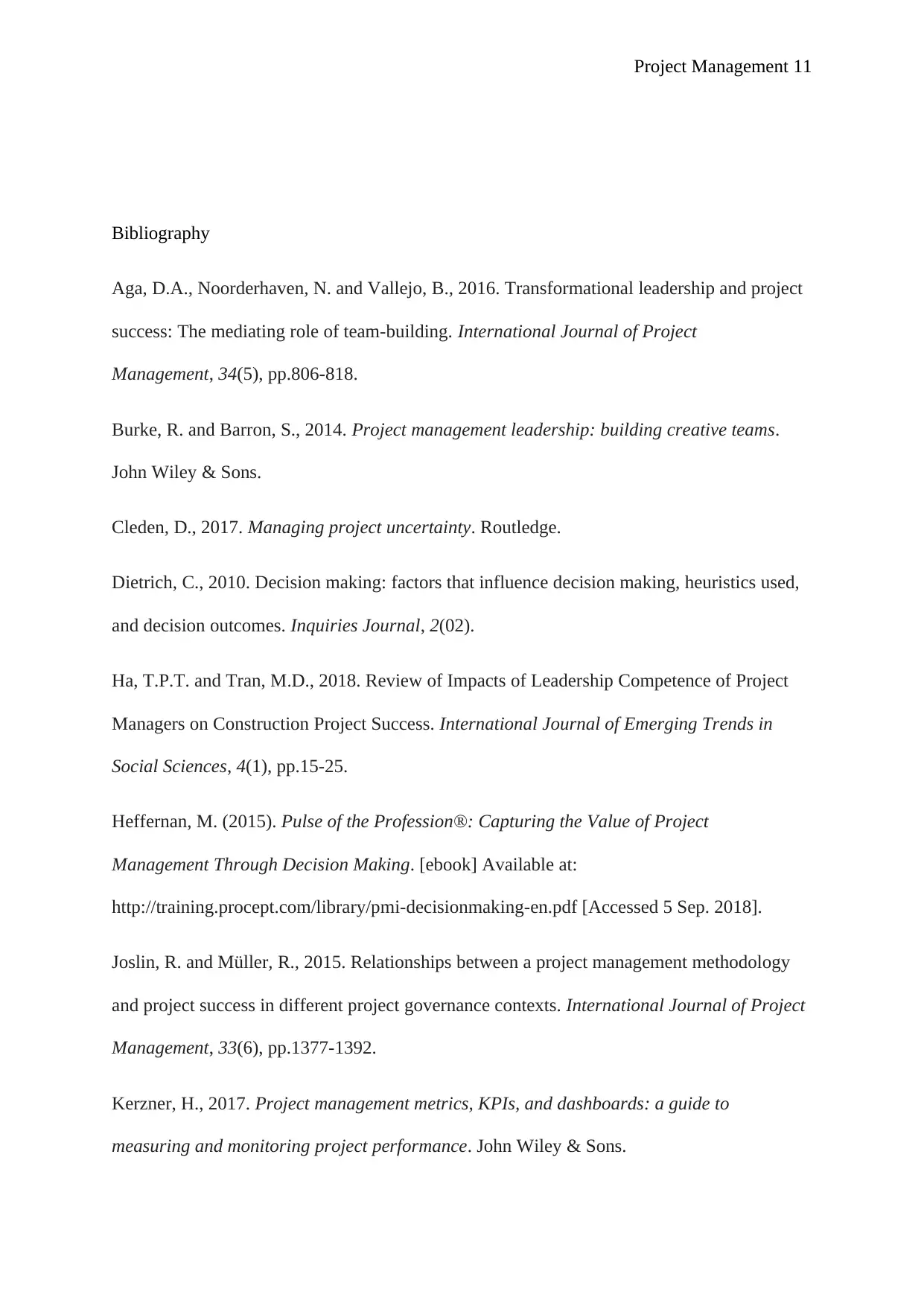
Project Management 11
Bibliography
Aga, D.A., Noorderhaven, N. and Vallejo, B., 2016. Transformational leadership and project
success: The mediating role of team-building. International Journal of Project
Management, 34(5), pp.806-818.
Burke, R. and Barron, S., 2014. Project management leadership: building creative teams.
John Wiley & Sons.
Cleden, D., 2017. Managing project uncertainty. Routledge.
Dietrich, C., 2010. Decision making: factors that influence decision making, heuristics used,
and decision outcomes. Inquiries Journal, 2(02).
Ha, T.P.T. and Tran, M.D., 2018. Review of Impacts of Leadership Competence of Project
Managers on Construction Project Success. International Journal of Emerging Trends in
Social Sciences, 4(1), pp.15-25.
Heffernan, M. (2015). Pulse of the Profession®: Capturing the Value of Project
Management Through Decision Making. [ebook] Available at:
http://training.procept.com/library/pmi-decisionmaking-en.pdf [Accessed 5 Sep. 2018].
Joslin, R. and Müller, R., 2015. Relationships between a project management methodology
and project success in different project governance contexts. International Journal of Project
Management, 33(6), pp.1377-1392.
Kerzner, H., 2017. Project management metrics, KPIs, and dashboards: a guide to
measuring and monitoring project performance. John Wiley & Sons.
Bibliography
Aga, D.A., Noorderhaven, N. and Vallejo, B., 2016. Transformational leadership and project
success: The mediating role of team-building. International Journal of Project
Management, 34(5), pp.806-818.
Burke, R. and Barron, S., 2014. Project management leadership: building creative teams.
John Wiley & Sons.
Cleden, D., 2017. Managing project uncertainty. Routledge.
Dietrich, C., 2010. Decision making: factors that influence decision making, heuristics used,
and decision outcomes. Inquiries Journal, 2(02).
Ha, T.P.T. and Tran, M.D., 2018. Review of Impacts of Leadership Competence of Project
Managers on Construction Project Success. International Journal of Emerging Trends in
Social Sciences, 4(1), pp.15-25.
Heffernan, M. (2015). Pulse of the Profession®: Capturing the Value of Project
Management Through Decision Making. [ebook] Available at:
http://training.procept.com/library/pmi-decisionmaking-en.pdf [Accessed 5 Sep. 2018].
Joslin, R. and Müller, R., 2015. Relationships between a project management methodology
and project success in different project governance contexts. International Journal of Project
Management, 33(6), pp.1377-1392.
Kerzner, H., 2017. Project management metrics, KPIs, and dashboards: a guide to
measuring and monitoring project performance. John Wiley & Sons.
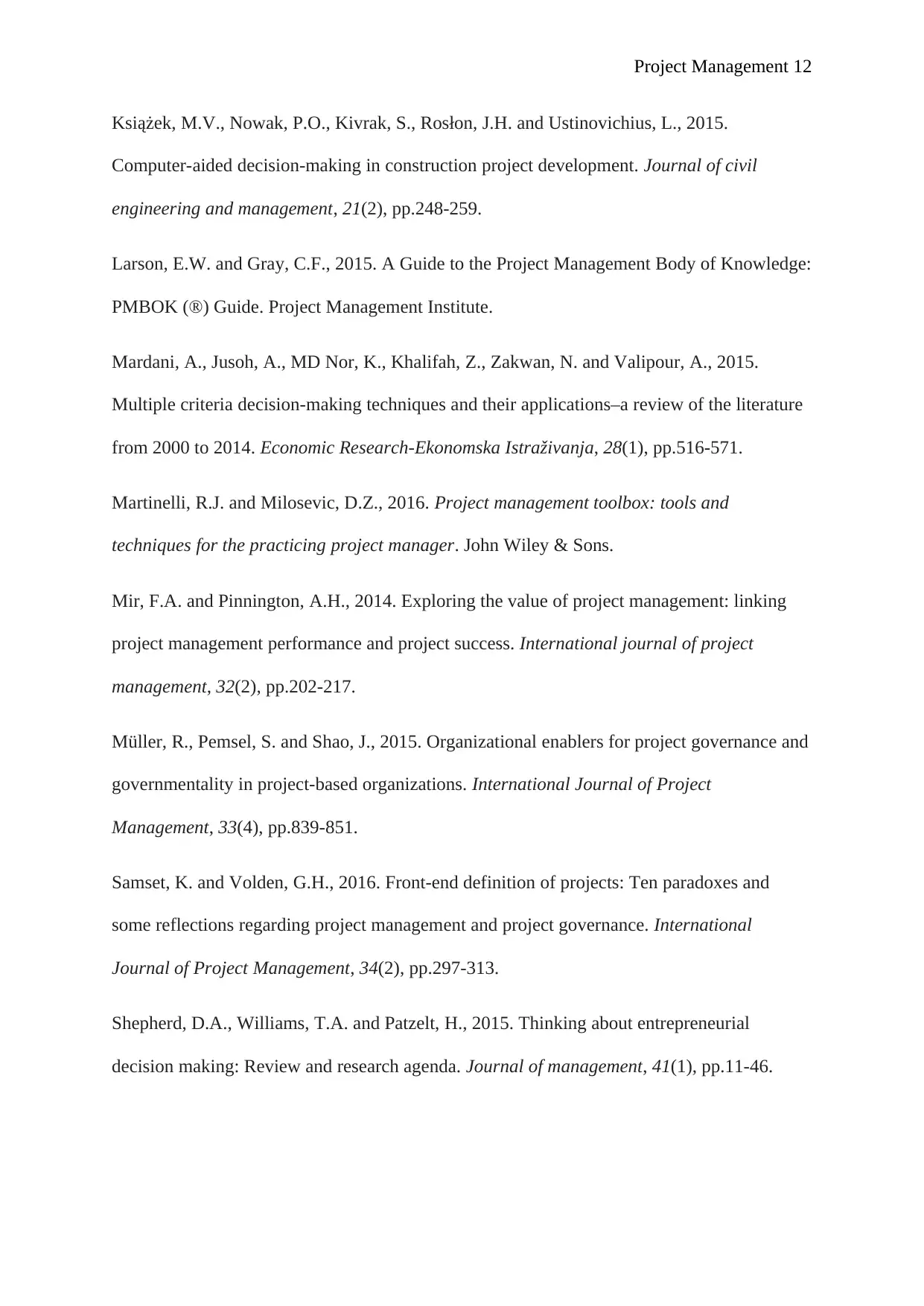
Project Management 12
Książek, M.V., Nowak, P.O., Kivrak, S., Rosłon, J.H. and Ustinovichius, L., 2015.
Computer-aided decision-making in construction project development. Journal of civil
engineering and management, 21(2), pp.248-259.
Larson, E.W. and Gray, C.F., 2015. A Guide to the Project Management Body of Knowledge:
PMBOK (®) Guide. Project Management Institute.
Mardani, A., Jusoh, A., MD Nor, K., Khalifah, Z., Zakwan, N. and Valipour, A., 2015.
Multiple criteria decision-making techniques and their applications–a review of the literature
from 2000 to 2014. Economic Research-Ekonomska Istraživanja, 28(1), pp.516-571.
Martinelli, R.J. and Milosevic, D.Z., 2016. Project management toolbox: tools and
techniques for the practicing project manager. John Wiley & Sons.
Mir, F.A. and Pinnington, A.H., 2014. Exploring the value of project management: linking
project management performance and project success. International journal of project
management, 32(2), pp.202-217.
Müller, R., Pemsel, S. and Shao, J., 2015. Organizational enablers for project governance and
governmentality in project-based organizations. International Journal of Project
Management, 33(4), pp.839-851.
Samset, K. and Volden, G.H., 2016. Front-end definition of projects: Ten paradoxes and
some reflections regarding project management and project governance. International
Journal of Project Management, 34(2), pp.297-313.
Shepherd, D.A., Williams, T.A. and Patzelt, H., 2015. Thinking about entrepreneurial
decision making: Review and research agenda. Journal of management, 41(1), pp.11-46.
Książek, M.V., Nowak, P.O., Kivrak, S., Rosłon, J.H. and Ustinovichius, L., 2015.
Computer-aided decision-making in construction project development. Journal of civil
engineering and management, 21(2), pp.248-259.
Larson, E.W. and Gray, C.F., 2015. A Guide to the Project Management Body of Knowledge:
PMBOK (®) Guide. Project Management Institute.
Mardani, A., Jusoh, A., MD Nor, K., Khalifah, Z., Zakwan, N. and Valipour, A., 2015.
Multiple criteria decision-making techniques and their applications–a review of the literature
from 2000 to 2014. Economic Research-Ekonomska Istraživanja, 28(1), pp.516-571.
Martinelli, R.J. and Milosevic, D.Z., 2016. Project management toolbox: tools and
techniques for the practicing project manager. John Wiley & Sons.
Mir, F.A. and Pinnington, A.H., 2014. Exploring the value of project management: linking
project management performance and project success. International journal of project
management, 32(2), pp.202-217.
Müller, R., Pemsel, S. and Shao, J., 2015. Organizational enablers for project governance and
governmentality in project-based organizations. International Journal of Project
Management, 33(4), pp.839-851.
Samset, K. and Volden, G.H., 2016. Front-end definition of projects: Ten paradoxes and
some reflections regarding project management and project governance. International
Journal of Project Management, 34(2), pp.297-313.
Shepherd, D.A., Williams, T.A. and Patzelt, H., 2015. Thinking about entrepreneurial
decision making: Review and research agenda. Journal of management, 41(1), pp.11-46.
⊘ This is a preview!⊘
Do you want full access?
Subscribe today to unlock all pages.

Trusted by 1+ million students worldwide
1 out of 13
Related Documents
Your All-in-One AI-Powered Toolkit for Academic Success.
+13062052269
info@desklib.com
Available 24*7 on WhatsApp / Email
![[object Object]](/_next/static/media/star-bottom.7253800d.svg)
Unlock your academic potential
Copyright © 2020–2025 A2Z Services. All Rights Reserved. Developed and managed by ZUCOL.





